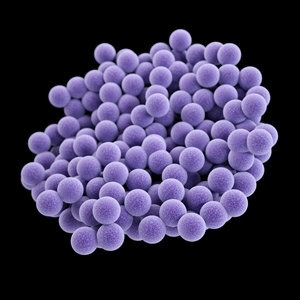2 January 2014. Researchers at Duke University and University of Connecticut wrote a mathematical model with open-source software that predicts mutations in bacteria to help design treatments for bacteria resistant to antibiotics. A team of computer scientists and biochemists from the two universities published their findings on 31 December 2014 in Proceedings of the National Academy of Sciences (paid subscription required).
The researchers, led by Duke’s Bruce Donald and UConn’s Amy Anderson, are seeking better drug design tools to test the potential effectiveness of new treatments for infections. While antibiotics greatly reduce illnesses and deaths from infections, the wide use of these drugs contibutes to microbes developing resistance to current drugs. Centers for Disease Control and Prevention estimates at least 2 million in the U.S. people develop infections resistant to antibiotics each year, leading to some 23,000 deaths.
Donald, Anderson, and colleagues adapted software from the open source protein-design package Osprey, short for Open Source Protein REdesign for You. The software offers algorithms for modeling proteins to capture changes in chemistry from mutations in corresponding genomes, and test bindings of proteins with their ligands or chemical connectors. Osprey is available as a free download from Donald’s lab.
The researchers used a routine in Osprey, called the K algorithm, that mathematically tests combinations of proteins and ligands for the most likely ensembles to result from a mutation. In this case, the algorithm modeled genomic variations, called single-nucleotide polymorphisms or SNPs, in methicillin-resistant Staphylococcus aureus (MRSA) bacteria. CDC estimates more than 80,000 annual cases of MRSA infection occur in the U.S., leading to more than 11,000 deaths.
The team specifically tested SNPs that provide resistance to a new class of experimental antibiotic drugs known as propargyl-linked antifolates. These compounds, still in preclinical testing, block activity of an enzyme called dihydrofolate reductase that feeds and recycles carbon atoms in the mutated DNA, thus stopping the development of a mutated bacteria. Anderson’s lab at UConn studies the role of propargyl-linked antifolates in fighting antibiotic resistance.
The Osprey model returned four SNPs with the ability to become resistant to propargyl-linked antifolates, which the researchers say were not previously known to have this potential. The researchers then treated a sample of MRSA bacteria in the lab with propargyl-linked antifolates that killed some, but not all, of the bacteria. By sequencing the DNA of the surviving MRSA, the team found more than half of the survivors’ DNA carried two of the four mutations predicted by the model.
The Duke-UConn authors believe applying mathematical models to predict “drug resistance mutations early in the discovery phase would be an important breakthrough in drug development.” Current methods require look-ups on databases reporting known mutations, but the new study shows not all mutations are always known, giving an advantage to computational methods.
Read more:
- Analytics, Genomics Companies Partner on Cancer Therapies
- Human Longevity Accessing Twins Genomic Database
- Genomic Data Analysis Service Launches, Hosts Autism Data
- Gene Editing Techniques Devised to Combat Superbugs
- Trial Testing Genetic Profiles for Personal Cancer Therapy
* * *


 RSS - Posts
RSS - Posts
[…] Computer Model Predicts Bacteria Mutations, Aids Drug Design […]
[…] Computer Model Predicts Bacteria Mutations, Aids Drug Design […]